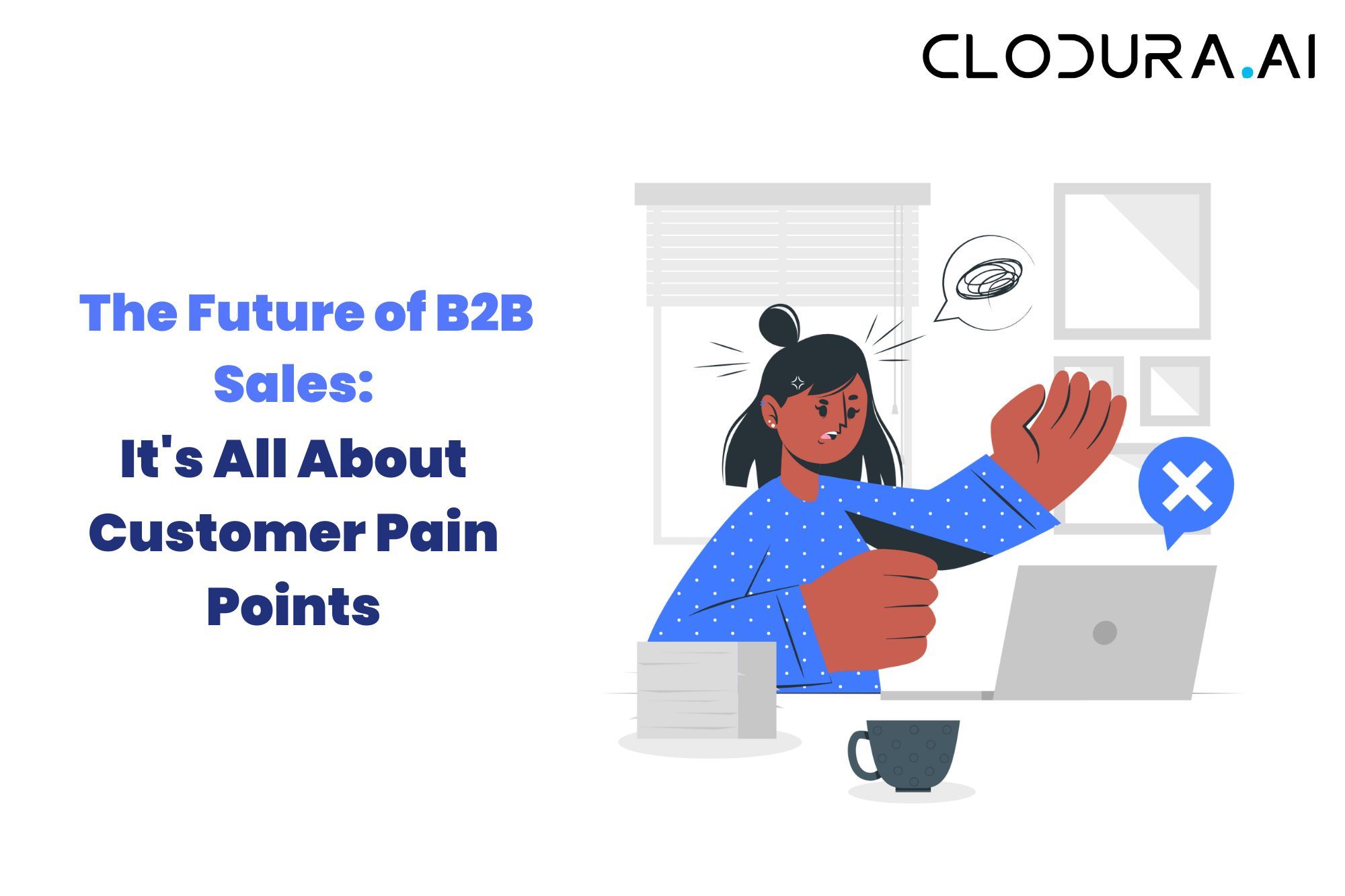In the fast-paced world of business-to-business (B2B) sales, understanding and addressing customer pain points play a crucial role in driving success. Pain points refer to the challenges, frustrations, and problems that customers experience in their businesses.
By identifying and solving these pain points, B2B companies can not only improve their sales performance but also build stronger and more long-lasting customer relationships.
Understanding the Impact of Pain Points on B2B Sales
When it comes to B2B sales, a deep understanding of customer pain points is essential for several reasons. First and foremost, knowing the pain points allows sales teams to align their products or services with the customer's specific needs. By highlighting how their offerings can alleviate these pain points, B2B companies can position themselves as valuable partners rather than mere vendors.
Moreover, addressing pain points enables B2B sales representatives to establish trust and credibility with their customers. When customers feel that a salesperson truly understands their challenges and can offer effective solutions, they are more likely to engage in a meaningful conversation and consider the proposed offerings seriously.
One common pain point in B2B sales is the challenge of managing complex supply chains. Many businesses struggle with coordinating multiple suppliers, ensuring timely delivery of goods, and maintaining quality control throughout the process. This can lead to inefficiencies, delays, and increased costs.
By understanding this pain point, B2B sales teams can position their products or services as solutions that streamline supply chain management. They can highlight features such as real-time tracking, automated inventory management, and seamless integration with existing systems. This not only addresses the customer's pain point but also demonstrates the value and ROI of the offering.
Another significant pain point in B2B sales is the need for cost reduction. Many businesses are constantly looking for ways to cut expenses and improve their bottom line. Sales teams that understand this pain point can emphasize how their offerings can help reduce costs in various areas, such as production, logistics, or administrative processes.
For example, a software company selling an enterprise resource planning (ERP) system can highlight how their solution can streamline operations, eliminate manual data entry, and reduce the need for multiple software licenses. By quantifying the potential cost savings, the sales team can effectively address the customer's pain point and present a compelling business case for their product.
Furthermore, understanding pain points also allows B2B sales teams to anticipate objections and proactively address them. By identifying the common concerns or hesitations that customers may have, sales representatives can prepare persuasive arguments or provide additional evidence to alleviate those concerns.
For instance, if a customer expresses concerns about the implementation process or the learning curve associated with a new software solution, the sales team can share success stories from other clients who have gone through a smooth transition. They can also offer training programs or ongoing support to ensure a seamless integration and minimize any disruptions to the customer's operations.
Overall, a deep understanding of customer pain points is crucial in B2B sales. By aligning their offerings with the customer's specific needs, addressing pain points, and proactively addressing objections, sales teams can establish trust, credibility, and position themselves as valuable partners. This not only improves the chances of closing a sale but also fosters long-term customer relationships based on mutual success and satisfaction.
Different signals in understanding the buyer's intent.
How AI and Data Analytics are Helping B2B Companies Identify and Solve Customer Pain Points
In today's data-driven era, B2B companies can leverage the power of artificial intelligence (AI) and advanced data analytics to identify and solve customer pain points more effectively. By analyzing vast amounts of customer data, such as purchase history, customer feedback, and industry trends, AI algorithms can uncover patterns and insights that may not be immediately apparent to human analysts.
This data-driven approach enables B2B companies to gain a comprehensive understanding of their customers' pain points. Armed with this knowledge, they can develop personalized sales strategies that address the specific challenges faced by each customer. Whether it's streamlining operations, improving efficiency, or reducing costs, data-driven insights can empower B2B companies to deliver tailored solutions that resonate with their customers.
One of the key benefits of AI and data analytics in the B2B space is the ability to identify pain points that may have been overlooked or underestimated. Traditional methods of gathering customer feedback, such as surveys and focus groups, can provide valuable insights, but they are limited by the sample size and the ability of participants to articulate their pain points accurately.
With AI algorithms, B2B companies can analyze large datasets that include not only explicit customer feedback but also implicit signals, such as browsing behavior and social media interactions. By considering these diverse data sources, AI can uncover hidden pain points that may have been missed by traditional methods.
For example, an AI algorithm may identify a pattern where customers who frequently visit a certain page on a company's website tend to have a specific pain point. Armed with this insight, the company can then develop targeted solutions to address that pain point and improve the overall customer experience.
Furthermore, AI and data analytics can help B2B companies prioritize their efforts by identifying pain points that have the greatest impact on customer satisfaction and loyalty. By analyzing customer data and correlating it with key performance indicators, such as customer retention rates and revenue growth, AI algorithms can pinpoint the pain points that have the most significant influence on business outcomes.
For example, an AI algorithm may discover that a specific pain point, such as slow response times to customer inquiries, is strongly correlated with customer churn. Armed with this insight, the company can prioritize efforts to improve response times and reduce customer churn, leading to increased customer satisfaction and long-term business growth.
In addition to identifying pain points, AI and data analytics can also help B2B companies develop innovative solutions that address customer needs in a proactive and forward-thinking manner. By analyzing industry trends and market data, AI algorithms can identify emerging pain points that customers may not even be aware of yet.
For instance, an AI algorithm may detect a rising trend in customer complaints related to a specific product feature. By proactively addressing this pain point and developing a solution before it becomes widespread, a B2B company can gain a competitive advantage and position itself as an industry leader in customer satisfaction.
Overall AI and data analytics are powerful tools that enable B2B companies to identify and solve customer pain points more effectively. By analyzing vast amounts of customer data, AI algorithms can uncover hidden insights and patterns that may have been missed by traditional methods. Armed with this knowledge, B2B companies can develop personalized sales strategies, prioritize their efforts, and proactively address emerging pain points. With AI and data analytics, B2B companies can deliver tailored solutions that resonate with their customers, leading to improved customer satisfaction, loyalty, and business growth.
Leveraging Pain Points to Increase B2B Sales
When it comes to increasing B2B sales, leveraging pain points is a winning strategy. By proactively addressing customer pain points, B2B companies can position themselves as problem solvers rather than salespeople. This approach involves actively listening to customers, asking the right questions, and empathizing with their challenges.
|
Build trust and credibility by empathizing with the customer's challenges and demonstrating your expertise.
By following these tips, you can leverage customer pain points to increase B2B sales and build lasting relationships with your customers.

Uncovering the Benefits of Pain Point Analysis for B2B Sales
Pain point analysis, which involves a systematic examination of customer pain points, offers numerous benefits for B2B sales organizations.
Firstly, it allows companies to prioritize their sales efforts. By understanding which pain points are most pressing for their customers, B2B organizations can allocate their resources effectively and focus on areas where they can deliver maximum value.
Secondly, pain point analysis enables B2B companies to develop targeted marketing and sales strategies. By tailoring their messaging and positioning to address specific pain points, companies can enhance their relevance and resonance with potential customers. This targeted approach not only increases the effectiveness of sales efforts but also streamlines the sales process by minimizing time spent on customers who are unlikely to benefit from the offering.
Crafting Targeted B2B Strategies Through Pain Points
A deep understanding of customer pain points can serve as a guiding light for crafting targeted B2B strategies. By aligning their products, services, and marketing campaigns with the specific challenges faced by their target customers, B2B companies can generate greater interest and engagement.
For example, if a B2B company specializes in software solutions for supply chain management, they can emphasize how their product streamlines operations, reduces costs, and improves overall efficiency – addressing pain points often experienced by procurement and logistics professionals. By highlighting these benefits and demonstrating expertise in solving these pain points, B2B companies can position themselves as trusted partners that add significant value to their customers' businesses.
Balancing B2B Sales and Pain Point Analysis
While pain point analysis is a crucial tool for B2B sales success, it is essential to strike a balance between analyzing pain points and executing sales strategies. It's easy to get caught up in data analysis and planning, but ultimately, the success of B2B sales relies on effective execution and building relationships with customers.
Therefore, B2B sales teams should combine data insights with on-the-ground experience and customer interactions. By continuously seeking feedback from customers and obtaining real-time insights, sales teams can adapt and refine their approach based on evolving pain points and market dynamics. Staying agile and responsive allows B2B companies to stay ahead of the curve and position themselves as trusted advisors to their customers.

Strengthening B2B Sales Through Pain Point Prioritization
Prioritization is a key aspect of pain point analysis in B2B sales. Not all pain points are created equal, and some may have a more significant impact on the customer's business than others. By prioritizing pain points based on their severity, prevalence, and potential for resolution, B2B companies can optimize their sales efforts and deliver the most value to their customers.
This prioritization process involves evaluating the potential benefits that addressing a specific pain point can bring to the customer. For example, if a pain point significantly hampers the customer's productivity or profitability, resolving it may result in substantial gains for the customer. By identifying these high-impact pain points and showcasing how their offerings can alleviate them, B2B companies can differentiate themselves from competitors and win over customers.
To Wrap Up,
As the future of B2B sales unfolds, the role of pain points in driving success will only continue to grow. Understanding, addressing, and leveraging customer pain points can position B2B companies as trusted partners and problem solvers, ultimately driving stronger sales performance and customer relationships. By harnessing the power of AI and data analytics, B2B organizations can gain deeper insights into their customers' pain points and develop targeted strategies that deliver maximum value.
By balancing data analysis with real-world interactions, companies can stay agile and responsive to evolving pain points and market dynamics. Through effective pain point prioritization, B2B companies can optimize their sales efforts and position themselves as industry leaders. Embracing the power of pain points is the key to unlocking a successful future for B2B sales.
FAQs
Q: Why is solving customer pain points so important for B2B sales?
Because customers want to buy solutions, not products or services.
Q: How can AI and data analytics help B2B companies identify and solve customer pain points?
By analyzing customer data and identifying patterns, AI can help B2B companies to identify the most common pain points and develop solutions that address them.
Q: What are the top 5 customer pain points that B2B sales teams should focus on in 2023?
Reducing costs, improving efficiency, increasing revenue, improving customer satisfaction, and reducing risk.
Q: How can B2B sales teams create a sales process that is centric on customer pain points?
By actively listening to customers, asking the right questions, and empathizing with their challenges. Sales teams can then use this information to tailor their sales pitches and develop solutions that directly address the customer's pain points.
Q: What are some ways that B2B companies can use customer pain points to build relationships and foster trust?
By proactively addressing customer pain points, B2B companies can position themselves as problem solvers rather than salespeople. This approach can help to build trust and credibility with customers, which can lead to long-term relationships and repeat business.


